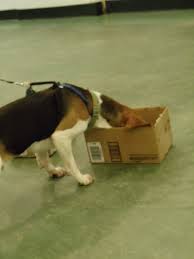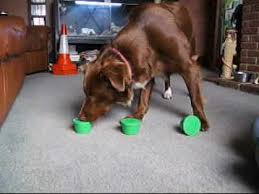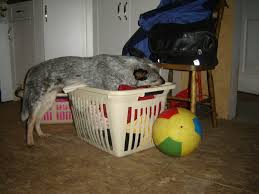Snooping games provide everyday fun for those occasional spare moments. Whether outdoors or inside the home, during a walk or from an armchair, you can train almost anywhere and with little preparation. These are fun games that offer mental stimulation for the overactive dog.
Food Search Games

One of the most popular search games has a very simple beginning the “search the treat” game. Begin by taking a treat and having the dog sit down. Show him the treat, put it on the ground a few meters away, go back to the dog and send him on his way with a wide sweeping movement of your hand. At the same time give your dog a verbal cue such as “search” or “find it” in an encouraging tone of voice. Repeat this a few times, and then lay out treats in such a way that the dog can’t see them anymore. After repeating it a few more times, go and hide it in the next room. In the beginning, use large, very visible and strong smelling treats, later you can use successfully smaller ones. Hide these in such a way that it will be increasingly difficult to sniff them out; under carpets, on chairs, under cushions, on a step, behind a lamp, under a newspaper, between two towels.
Be creative!
Next, show your dog two treats, then ask him to sit down, while you hide the treats. You will see how quickly your expert sniffer will learn how to count. If you only hide two or three pieces, he will soon surprise you by only searching for these, and not a single one more. If, later on, you would like to keep him busy for longer, show him a whole handful. You already know that sniffing is a self rewarding activity. The more the dog sniffs around, the longer he will want to keep doing it. The “search for treats” can be easily extended to include the garden, porch, or during walks. At first, the many external stimuli may be distracting for your dog. Proceed slowly and systematically, exactly the same way as you did when you first started. Only increase the level of difficulty when the dog is able to concentrate, and is enjoying himself. Don’t ever put him under any pressure, because you think he should be able to do this or that by now. It would be much better to use particularly nice smelling treats for a particularly hungry dog. Throw them in a high- arch trajectory onto a freshly mowed lawn make it as easy as possible for your dog. Once again, bear in mind, as soon as the treats go flying, the dog tends to run after them. Have him wait a short moment before you release him with your search command.

In addition, you have to take into consideration the wind direction. To begin with, the wind should always be blowing toward you, making things much easier for the dog, this way he will learn first of all to work with his nose in the air and in a larger area. Later, when you go for a side wind or tail wind in particular, things will become more difficult.
This is a good way to get into nose work. From now on you have infinite scope for variation at your disposal. Have your snooper trainee search for his food bowl, his chew stick, his stuffed Kong, or scent tubes. However, you will always have to show him what exactly it is that he is supposed to search for. If possible, always use the same search cue. Soon, he will happily give you his full attention every time you say this word, because he associates something exciting with it.

You can make it even more difficult for your dog if you hide the treats which we have shown him beforehand (or the food bowl, the Kong or the scent tubes) inside a tin or a box with holes. Place the tin inside the box. Now he has to find the tin and open it, before he can get to his treats.
At this point you could also work with a marker. If the dog is unable to open or fetch the tin, or the cardboard box, he has to mark or show his find. I have taught my dogs to sit at the find, but you could have them bark or scratch.
Packages with Goodies Everyone
This is another fun variation. Collect cardboard tubes from paper towel or toilet paper rolls and train your dog to fetch these without breaking them. Next, fill several cardboard tubes with a treat, and fold down the edges to close the tubes. He should be taught to bring you these without unwrapping them. Open them together once your dog finds them, and give him the goodies inside. This requires a lot of self discipline on the dog’s part. Next, hide several packages all over the house, under a rug, on a shelf, in a corner, up high and down low, wherever you can think of. The dog enjoys the search, and we enjoy watching them thoroughly search.
The Cup Game

We’re all familiar with cup games, where someone must choose under which cup the treat or object is hidden. To begin, use two upside down cups that are the same color and have holes in the bottom. Plastic flower pots are ideal for this game. They should be the same color-as we already know-dog’s can only see a limited range of colors and should not end up being misled by them.
Begin by having your dog sit down, and place a treat under one of the cups while he is watching you. Then give your search cue, and let him knock over the cup and eat the treat. Repeat this exercise two or three times. Now, have him sit down again, and put a treat under one of the cups, but this time shuffle the cups around each other for a bit. Just like a real cup game, this ensures the dog no longer knows which cup hides the treat. Then once again, give your search cue. If the snooper trainee knocks over the cups without sniffing them, you will have to hold onto them. At some point he will sniff the correct cup. When this happens, lift it up immediately or let him knock it over, and the dog is allowed to help himself to the treat.

Once your dog is able to find the search object under one of the cups every time, increase the number of cups to 3, 4 or even more. Or, as a variation of the search game, you can use cardboard boxes instead of cups. Shoe boxes work well, with small holes cut into the lids. Now you can hide a toy, treats or even his entire food bowl inside. You can decide if you want your dog to lift the lid or mark the find. Just as before, the boxes should be identical in the beginning, you can increase the level of difficulty later by hiding toys in various looking boxes.
Find the Duck
 The next search game is about learning some vocabulary, with the simultaneous use of the nose. Our dog is supposed to identify a number of toys by their names and then to search for them. As a consequence, we have to hide the toys in such a way that he can’t find them by just using his eyes. That would be far too easy!
The next search game is about learning some vocabulary, with the simultaneous use of the nose. Our dog is supposed to identify a number of toys by their names and then to search for them. As a consequence, we have to hide the toys in such a way that he can’t find them by just using his eyes. That would be far too easy!
As a first step, the dog has to learn that a duck is called a duck, and a ball is called a ball. Begin by showing him the first toy, in this case it is a plastic duck. Say duck at the same time and have your dog sniff it. Next, put the duck on the ground, point towards it, and say to your dog “search or find duck”. When your dog fetches the duck, or marks it,be sure you praise him. If he shows no interest in the duck when your just putting it on the ground, throw it high up into the air and have him run after it, while at the same time saying “duck”. After doing this a few times, conclude this unit of training.
For the next step, have the dog sit down and let him watch as you hide the duck. Even at this stage, you should start to think of increasingly difficult hiding places. Make sure that your dog doesn’t spot the duck first off, instead of sniffing it out. Have him sit down, then hide the duck in a different room, but hide it somewhere he can easily find it. You can ask him to go on longer, more difficult searches as he progresses.
 Only repeat the training approach described above with a different toy once you have gotten to this point. Initially, let your dog search for only this one toy. Eventually, you can alternate between different toys, always in association with the relevant name. After a number of successful repetitions, put him to the test. Hide both toys at the same time. Will your dog really search for the duck when you tell him too? It can take a while before your dog can identify the toys by their name. Once he is able to tell the two toys apart, you can add a third. Give this a name too, and train with it separately, without the two already familiar toys. Once the dog has learned the new name, hide all three toys at the same time, and after initially having him search for the new one, he can later randomly search for all three.
Only repeat the training approach described above with a different toy once you have gotten to this point. Initially, let your dog search for only this one toy. Eventually, you can alternate between different toys, always in association with the relevant name. After a number of successful repetitions, put him to the test. Hide both toys at the same time. Will your dog really search for the duck when you tell him too? It can take a while before your dog can identify the toys by their name. Once he is able to tell the two toys apart, you can add a third. Give this a name too, and train with it separately, without the two already familiar toys. Once the dog has learned the new name, hide all three toys at the same time, and after initially having him search for the new one, he can later randomly search for all three.
You can also teach your snoopster to sniff out anything, not just toys. What about teaching them to search for a scarf, a hat, gloves or even lost car keys? While on a walk, drop your glove, walk a little distance, turn around at some point, and have your dog search for the dropped object by saying “glove”.
One Duck, Many Places
Next, a variation of hiding the duck. Take the duck and have your dog sit down. Now walk from one hiding place to the other, pretending to hide the duck there. At some point you do put it down, but carry on like you are still pretending to hide it. Go to several other hiding places in the same manner, then go back to your dog and send him on the search.
Once you have put the duck in the hiding place, be careful to watch your body language. Your dog will instantly notice if you keep looking toward the actual hiding place, or if you turn in a certain direction. You could conduct an experiment where you help him on purpose with a turn of your body or a clear glance in the right direction. You will see how well your dog can read you.
 Laundry Baskets & Suitcases
Laundry Baskets & Suitcases
Filling laundry baskets and suitcases with clothes and hiding a toy or treat among them always gives rise to an interesting search task. Once again, the dog is not using his eyes, but using his nose. When he digs his nose in the laundry we can observe how he is taking in the smells while thinking it through at the same time, and how he is using his nose to sort through the laundry. Of all nose games, this one is a fun time.
Begin by initially showing the dog the object in which is is supposed to search. Take the opportunity to have him sit or lie down-which exercises his impulse control-and teach him the word “sniff” just by saying it when he is sniffing the object. Then, hide it while he is watching, mixing everything up in the laundry basket or suitcase. After that, go back to him, and send him on the search by saying your search cue and making by now that familiar, sweeping gesture.

Socks provide a fun alternative to the game. How many times are we certain that we have put both socks in the washing machine? And for some explicable reason only one of them emerges after the wash. Put a treat or a toy into a sock, hide it among all the other socks, and send your dog on the search. Once he has found the correct sock, let him fish out his prey. Be particularly watchful during this game to ensure greedy dogs don’t swallow the sock with the treat inside. Stay with your dog throughout and keep a close eye to be certain.
Telling Different Smells Apart
Telling different smells apart means that you teach your dog how to find out which object was the one that you previously held in your hand, or to distinguish between tea and coffee, or to mark whether or not a certain smell is present. For instance, mold detection dogs work along these lines, as well as police and customs dogs.
Up to now, your dog has been searching with his nose for things he has previously seen. He used both his eyes as well as his nose for this task. Now he is supposed to learn how to search for something that he has only smelled, but not seen beforehand. From now on, he will work using only his nose. When he sniffs an object, he picks up many different smells. Now he has to achieve a mental masterstroke, he is supposed to remember the smells. For the second step, he will sniff a totally different object, and compare the smells of both objects. If there is a match, he is supposed to fetch or mark the second object.
I love playing these fun games with my dogs. It is one of their favorite forms of entertainment. They have become real expert sniffers!






